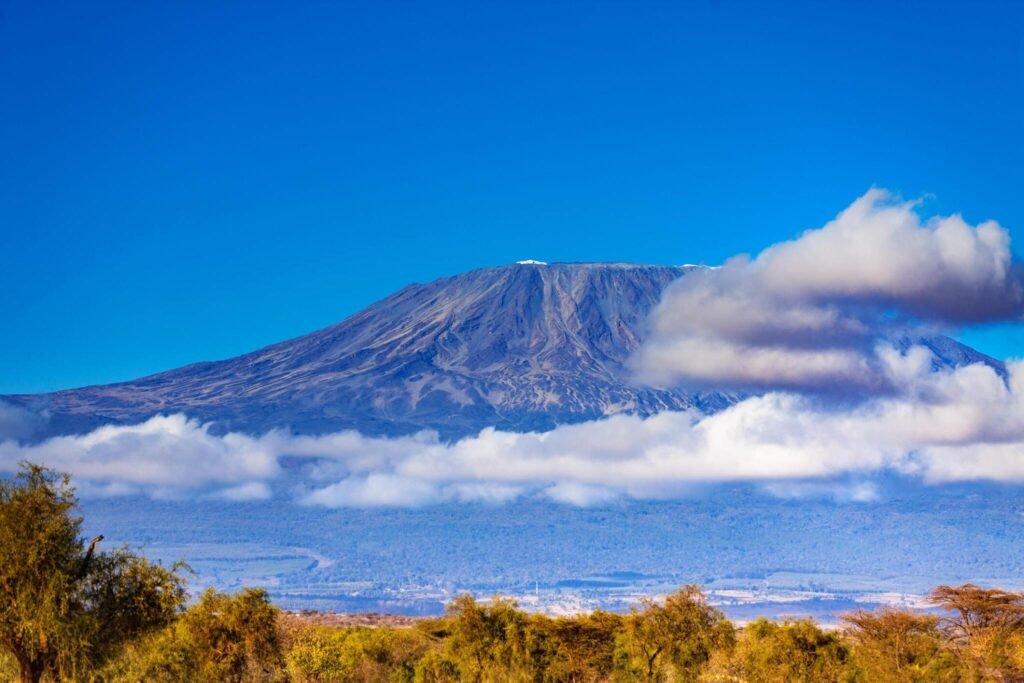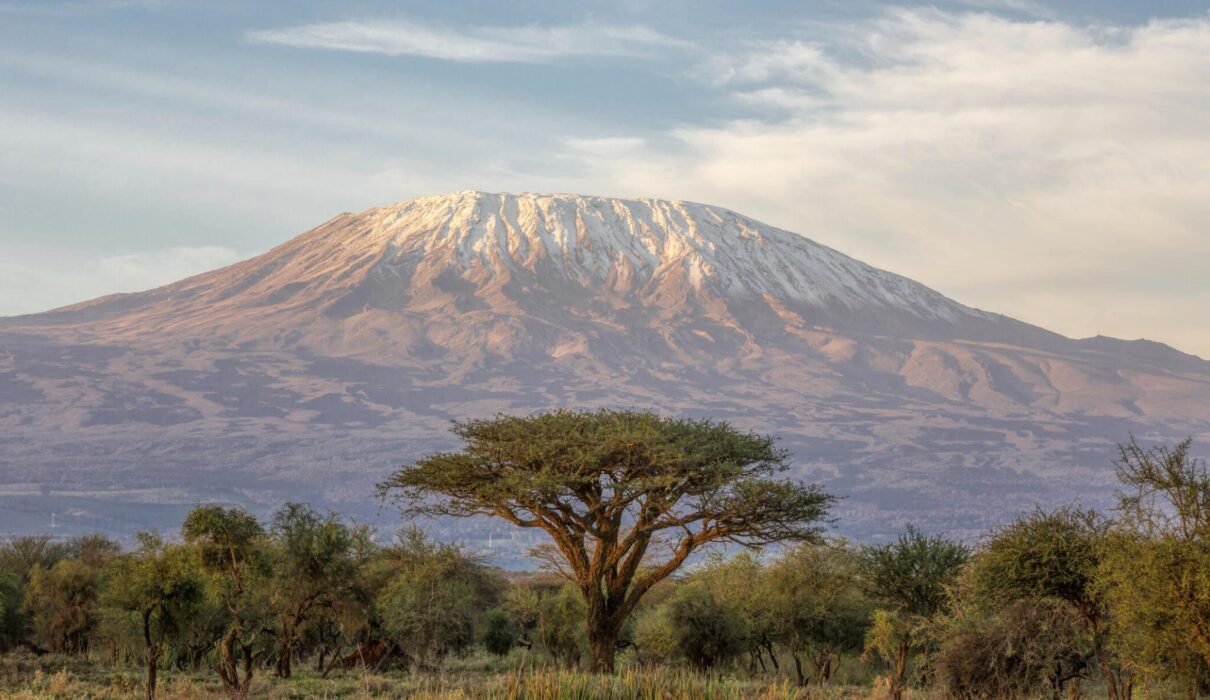Mount Kilimanjaro, the tallest free-standing mountain in the world, offers seven distinct routes to the summit. Each route provides a unique experience, with varying levels of difficulty, scenery, acclimatization opportunities, and crowd sizes. Whether you’re a beginner climber or a seasoned trekker, understanding these routes is essential for choosing the right path to the “Roof of Africa.”
In this post, we will explore the seven different Kilimanjaro routes, highlighting their key features and helping you decide which one suits your fitness level and trekking preferences.
Start planning your Kilimanjaro trek here.

1. Marangu Route (The Coca-Cola Route)
The Marangu Route is the oldest and most well-established path up Kilimanjaro, often called the “Coca-Cola Route” because of its relative ease and popularity. This is the only route where climbers stay in huts rather than tents, making it a preferred option for those seeking more comfort. However, it’s also known for having the lowest summit success rate due to its fast ascent.
Key Features:
- Duration: 5-6 days.
- Accommodation: Dormitory-style huts.
- Difficulty: Moderate, but the fast ascent can lead to altitude sickness.
- Best for: Beginners who prefer accommodation in huts.
Read more about the Marangu Route and tips for first-time climbers.
2. Machame Route (The Whiskey Route)
The Machame Route, also known as the “Whiskey Route,” is one of the most popular and scenic paths to the summit. It offers beautiful views and a varied landscape, but it’s also more challenging, with steeper inclines and longer trekking days. Machame allows for better acclimatization, which contributes to its high success rate.
Key Features:
- Duration: 6-7 days.
- Accommodation: Tents.
- Difficulty: Challenging, with steep climbs but good acclimatization opportunities.
- Best for: Adventurous trekkers looking for scenic views and higher success rates.
Explore the beauty of the Machame Route in more detail.
3. Lemosho Route
The Lemosho Route is one of the newer routes on Kilimanjaro and is praised for its panoramic views and low traffic, especially in the early stages. It merges with the Machame Route near the Lava Tower, offering trekkers scenic beauty combined with a gradual climb, which allows better acclimatization. This route is known for its high summit success rate.
Key Features:
- Duration: 7-8 days.
- Accommodation: Tents.
- Difficulty: Moderate to challenging, with plenty of time for acclimatization.
- Best for: Trekkers looking for stunning scenery and fewer crowds.
Discover why the Lemosho Route is ideal for acclimatization.
4. Rongai Route
The Rongai Route approaches Kilimanjaro from the northern side, near the Kenyan border, and is the least crowded of all the routes. It’s considered one of the easier options due to its gradual ascent, making it suitable for beginners. The Rongai Route offers unique, unspoiled wilderness views, although it’s less scenic compared to the southern routes.
Key Features:
- Duration: 6-7 days.
- Accommodation: Tents.
- Difficulty: Moderate, with a more gradual climb.
- Best for: Climbers seeking a quieter, less-traveled path.
Learn more about the Rongai Route and its remote beauty.
5. Shira Route
The Shira Route is similar to the Lemosho Route but starts further to the west, beginning at a higher altitude. The route initially takes you across the Shira Plateau, offering breathtaking views of the mountain and the surrounding landscape. However, starting at such a high altitude can increase the risk of altitude sickness for some climbers.
Key Features:
- Duration: 7-8 days.
- Accommodation: Tents.
- Difficulty: Moderate to difficult, with high altitude from the start.
- Best for: Trekkers who want a unique, scenic route and are comfortable with higher altitudes from the beginning.
Discover what makes the Shira Route unique.
6. Northern Circuit Route
The Northern Circuit Route is the longest and newest route on Kilimanjaro. It offers 360-degree panoramic views as you circle around the northern slopes of the mountain. The route is one of the least crowded, offering plenty of time for acclimatization, which contributes to its very high summit success rate.
Key Features:
- Duration: 9-10 days.
- Accommodation: Tents.
- Difficulty: Moderate to challenging, with the longest acclimatization period.
- Best for: Trekkers who want a remote, scenic route with excellent acclimatization.
Explore why the Northern Circuit is considered one of the best routes.
7. Umbwe Route
The Umbwe Route is the shortest and steepest route to Kilimanjaro’s summit, making it one of the most difficult. It’s a direct and less forgiving climb, with limited acclimatization opportunities. For this reason, Umbwe is recommended for experienced trekkers who are confident in their ability to handle the high altitude and steep ascents.
Key Features:
- Duration: 5-6 days.
- Accommodation: Tents.
- Difficulty: Very challenging, with rapid ascents and limited acclimatization time.
- Best for: Experienced trekkers seeking a physically demanding challenge.
Learn more about why the Umbwe Route is for experienced climbers only.
Choosing the Best Route for Your Kilimanjaro Climb
Selecting the right route depends on your experience, fitness level, and the kind of experience you’re looking for. Here are some factors to consider:
- Experience Level: Beginners should consider routes like Marangu or Rongai, which offer a more gradual ascent. Experienced climbers may prefer challenging routes like Umbwe or the Northern Circuit.
- Scenery: Routes like Lemosho, Shira, and Machame offer stunning scenery, while Rongai is less scenic but quieter.
- Acclimatization: If you’re concerned about altitude sickness, consider longer routes like Lemosho or the Northern Circuit, which offer better acclimatization.
- Crowds: For a more secluded experience, opt for Rongai, Lemosho, or the Northern Circuit.
For more personalized advice on choosing the right Kilimanjaro route, visit here.
Best Time to Climb Kilimanjaro
While Kilimanjaro can be climbed year-round, the best time to trek is during the dry seasons. These are typically from June to October and January to March, when the weather is more predictable and the paths are drier. The rainy seasons (April-May and November-December) make the routes more challenging due to slippery paths and reduced visibility.
Learn more about the best time to climb Kilimanjaro here.
Conclusion
Mount Kilimanjaro offers a range of routes for climbers of all skill levels, from the beginner-friendly Marangu Route to the challenging Umbwe Route. Each route has its own unique features, scenery, and difficulty levels, making Kilimanjaro an adventure suited to a wide variety of trekking preferences. By understanding the differences between the seven routes, you can choose the one that best aligns with your goals and experience level.
For more detailed route information and expert guidance on planning your Kilimanjaro adventure, visit Kilimanjaro Climb Specialist or Eddy Tours & Safaris.

